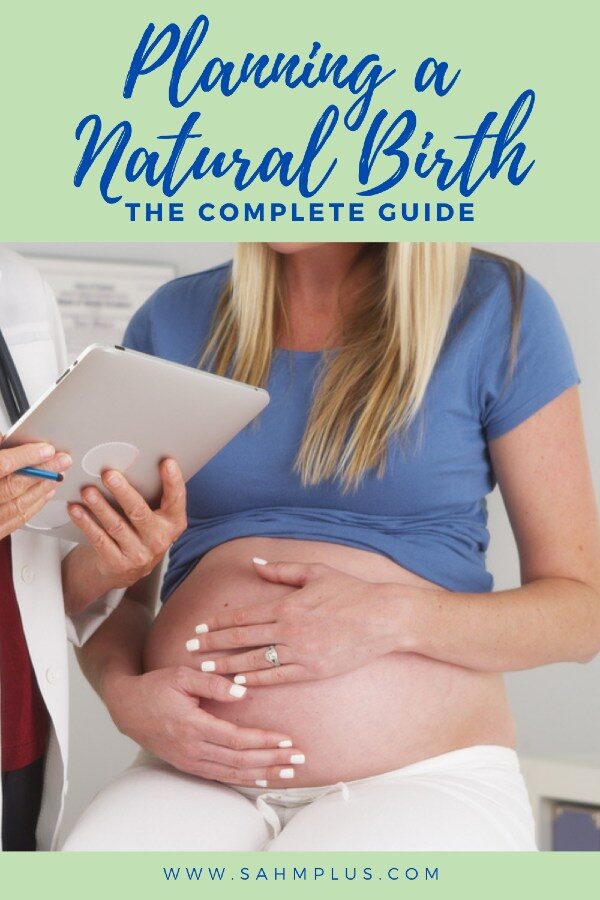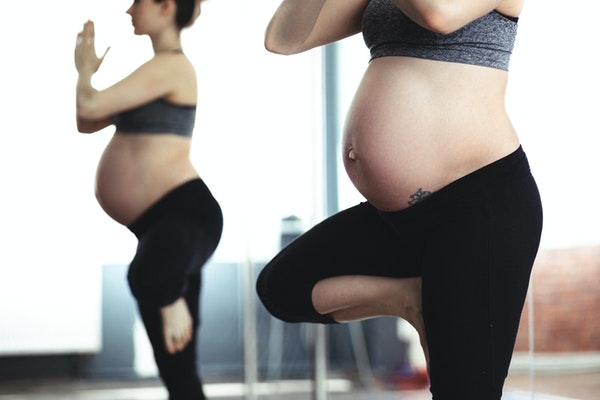Your preparation for natural childbirth will be off to a good start with our helpful guide. If you want to know how to prepare for natural birth, we discuss what natural birth is, its benefits, and things you should consider when planning. We will also give you a timeline for what happens when from home birth to hospital birth. Finally, we will review some specific things that can be helpful in a hospital birth and at homebirth.

What is a Natural Birth?
Childbirth has always been considered a natural process. However, in the last century or so, women have found themselves giving birth in the hospital. The question of whether this was right or not has been debated for decades. But now, people are starting to take another look at the benefits of natural birth and how they compare to hospital births.
Natural Birth:
- May include no pain relief or few if any other types of medications.
- Is the process of laboring and giving birth in positions that are comfortable to you.
- Allows you the time you need to birth your baby when your body is ready.
- Avoids unnecessary medical interventions.
Planning a natural birth is an option for those who prefer a more personal and deeply connected experience from start to finish. It can be accomplished at home or within a hospital setting with clear communication of your wishes and proper planning.
Natural birth may not be an option if you have certain medical conditions that would prevent you from delivering safely.
It is best to discuss your plans for a natural birth with a trusted medical provider as well as anyone you wish to support you through labor and delivery.
Types of Natural Births
There are several types of natural births and they can be categorized by the following:
- Unassisted Childbirth
- Assisted Childbirth
- Vaginal Birth
- Water Birth
- Home Birth
What are the Benefits of a Natural Birth?
There are many benefits of natural childbirth, which include:
- lower rates of illness
- less likelihood of postpartum depression
- a higher sense of control over the birthing process
- a more satisfying experience.
Many women who give birth naturally find the experience to be more empowering and rewarding. They feel as if they have been able to maintain some degree of control over their birthing process. And because they are not drugged up on medications, they feel as if they were able to experience childbirth on a deeper level (sometimes referring to the process as “primal”).
Things You Should Consider Before Planning A Natural Birth
Planning a natural birth may seem like an overwhelming process. It is important to take the time to plan for what is most important to you and your family. There are a number of considerations that should be made before deciding on natural birth.
- Do you know anyone with positive natural birth stories?
- Do you have any risk factors that might prevent you from having a natural birth?
- Is your partner supportive? Will he/she be willing to help you mentally/physically get through labor and to advocate for you during labor?
- If not, will you have a trusted friend, family member, or even a doula to help you? Will they advocate for you during labor?
- Will you create a birth plan? And how flexible will you be with it?
There are many differing opinions on whether or not it is safe or appropriate for a woman who has no previous history of complications in childbirth to labor and give birth without pain medication. Some people believe that there are potential risks involved in not using medications while others do not feel this way. For these reasons, it is important to align yourself with those who share your vision of the birth experience you desire.
To have the best experience possible, it is advisable to speak with your trusted medical professional about any personal health conditions or alternative treatment options that could cause complications during labor and childbirth.

How to Prepare for Natural Birth During Pregnancy
A lot of women today are trying to prepare for their baby’s arrival without the help of modern medicine. Some people feel that this is a better way to have a natural childbirth and motivates them to have a healthy pregnancy. This doesn’t mean that they don’t want to be prepared for possible emergencies, though. If you’re pregnant, you should think about how you’re going to prepare for your baby’s arrival by checking out these tips.
1) Join a local birth group or start one yourself if there isn’t one nearby
2) Find a childbirth educator – choose one that is trained in or has had a natural childbirth
3) Have emotional support from someone who is on board with your plans
4) Keep an emergency kit in your bag at all times
5) Eat well and stay active to keep your body fit and ready for birth
How to Prepare for Natural Birth at Home
Between 2004 and 2017, home births increased 77% and the majority of these were planned, indicating more families are choosing natural birth at home.
If you’re pregnant and considering a homebirth, it’s important to educate yourself and to prepare in advance. Homebirths are considered safe if the expectant mother is healthy and the pregnancy is uncomplicated.
Here are a few tips for planning a natural birth at home:
- Start with a childbirth preparation course: Women should try to take a childbirth preparation course before planning for their home birth; this can be done individually or in a group setting and will provide them with information about things like pain management techniques, breastfeeding, postpartum care and more.
- Consider delivery options: If there are any complications during pregnancy or labor, women should be prepared for how they will leave the house; this could include bringing along an emergency bag full of items such as clothing, toiletries, baby supplies, etc.
- Trained professional availability: Make sure that there is a well-trained professional available in case something goes wrong and you cannot deliver your baby by yourself.
- Team member preparation: Make sure that your team members are willing to help and are well-prepared for the event.
- Supplies: research what supplies are required to have on hand when delivering a baby at home.
Tips for Planning a Natural Birth in a Hospital or Birthing Center
The following tips will help you create a natural birth plan for the hospital or birthing center.
- Figure out what type of birth experience you want and then plan accordingly.
- Share your natural birth plan with your healthcare provider to ensure they’re on board. If they are not and lack medically logical reasons for being against natural childbirth, find a medical provider who will work with you.
- Healthy eating is important for pregnancy, and it helps during labor as well. So eat healthy foods and drink lots of fluids.
- Avoid caffeine and alcohol as these things can slow down contractions.
- If you have a partner or spouse that can be present during labor, make sure they are there because this will provide emotional support for the mother-to-be.
- If your partner or spouse cannot be present during labor make sure they are informed about what’s going on at all times to help them stay calm from a distance.
- Ask for support from friends and family members in person or online in order to keep in contact with them while you focus on the birth process.
- Ask your healthcare provider to discuss the range of pain relief options and the benefits and possible risks of each so that you can make informed decisions.
For more insights, check out these secrets I learned to help me prep for giving birth naturally.

What to Expect During the Birthing Process
The birthing process can be a healthy, fulfilling and powerful experience for the mother and the child. But, it can also be a very confusing and overwhelming process so it’s important to know what to expect in order to feel less stressed or scared.
This section will discuss how it is not abnormal to feel afraid of childbirth, how to induce labor naturally, and what to expect during childbirth.
Fear of Childbirth
Fear of childbirth is often a natural response during pregnancy and this anxiety can stem from a variety of sources. For some, it may be memories from previous births that have gone wrong or the fear that they might not be able to cope either physically or emotionally. For others, they may have heard repeatedly how painful birth is.
A lot of women who fear childbirth think that their fears will never go away and believe that it is impossible to overcome the fear. These fears can lead many women to forgo planning a natural birth, but there are simple steps and techniques through which you can help yourself overcome the fear of giving birth.
The most important thing is not to judge yourself for having this fear and then beating yourself up for it. It’s okay to be scared because this is a big moment in your life!
Although we understand the natural process of being afraid of what we don’t know, it is important to resolve those fears well before labor. According to this study, being afraid of labor “had a negative effect on women’s emotional health during pregnancy and increased the likelihood of a negative birth experience.”
The Birthing Process
The birthing process is divided into three stages: early labor, active labor and transition.
- Early Labor: typically lasts for about six hours and it includes contractions that prepare the cervix and uterus for birth.
- Active Labor: when uterine contractions become more frequent, stronger, and finally, lead to pushing during transition.
- Transition Stage: takes about two hours on average, but it can last longer or shorter depending on the circumstances.
Inducing Labor Naturally
The process of attempting to induce labor is not a new concept. In fact, it has been around for centuries.
Many women these days are being offered several ways to induce labor, though usually, these are medically or mechanically implemented techniques. One fact of medical induction is that it can lead to a cascade of interventions and lessen the chances of having a natural birth.
Typically, women who skipped induction of labor recover more quickly than those who were induced.
Infants who are born after a full-term pregnancy may also experience other benefits such as:
- more time to build muscle and strength
- reduced risk of low blood sugar, infection, and jaundice
- improved breathing as infants born even as little as two weeks early can experience twice the number of complications
- better feeding once born
- increased brain development, with the brain growing a third of its size between weeks 35 and 40
For these reasons, women who are planning a natural birth seek out alternative options and opt for natural induction techniques.
If you want to induce labor naturally, you may try these ideas:
Have Sex
“Having sex and especially having an orgasm, releases oxytocin which triggers contractions. The prostaglandin hormone in semen may help ripen your cervix,” says Victoria Glass M.D., a practicing doctor with a focus on medical research.
She places a strong emphasis on not having sex “after your water has broken because it increases the risk of infection.”
Breast/nipple stimulation
Amanda, pregnancy and childbirth coach & doula, suggests that “[w]hile there are few things that you can do to induce if your body and baby are not ready there are some options you can explore. One that has worked for myself and many other women is nipple stimulation. Whether that be through fun time with your spouse or using a pump like I did, pumping or nipple stimulation causes the uterus to contract which can induce labor. If pumping, you can pump on each side individually or on both at the same time, as you are pumping when contractions come on, stop the pump until the contraction has passed and then start pump again, do this for no more than 25 minutes at a time. You can start doing this in the evenings as you feel it is getting closer or if your water has broken and contractions are not picking up.”
Exercise
“Exercises are one of the most natural and most effective ways to induce labor for any expectant lady and it has shown rewarding results,” says Kimberly Langdon M.D., a retired, board-certified obstetrician/gynecologist.
She continues by saying “[a]nything that gets your heart rate up can be good exercise, helping to relieve stress and keep your body strong. Walking and swimming are often popular choices during pregnancy. Climbing stairs also opens your pelvis, putting pressure on the cervix and helping put the baby in the correct position for delivery.”
Get baby into a good position
Mindy, Certified Childbirth Educator and author of Cut Your Labor in Half: 19 Secrets to a Faster & Easier Birth has a bit to say about baby’s position! “Wouldn’t it be wonderful if there was a natural induction method that was 100% effective? Sadly, that is not the case and most ideas have a very small chance of success. Based on 15 years of birth stories and research, I’d say the most effective method has three components: getting the baby in the occiput anterior (OA) position with a fetal station of 0 or +1 and then add walking or deep squats. The theory behind getting the baby OA and engaged is to keep the baby’s weight off the mother’s body as much as possible and to align the mother’s body through stretching, good posture and pelvic tilting.”
“A baby that is low and well-positioned in the mother’s pelvis has a much better chance of triggering the brain to stimulate the oxytocin that then starts contractions. With a clinical hospital induction, the cervical ripening method considered the most natural is the Foley balloon. It works by putting the same kind of pressure on the woman’s cervix (with a water balloon) that a well-engaged (0 or +1 station) head would during a rigorous walk or by hanging out in the ‘dangle’ (deep squat) position.”
“I have never seen an RCT on good positioning and walking versus raspberry leaf tea, a warm bath, sex/sperm to ripen the cervix, etc However what we do know is that babies in the OA position that are well engaged almost always make for faster easier labors.”
Eat Dates
Dr. Glass weighs in on eating dates saying they “[r]educe the need for oxytocin, the medication used to induce labor, and soften your cervix before delivery.”
Take Castor Oil
“Castor oil stimulates prostaglandin which ripens the cervix and kick-starts labor.” Dr. Glass also warns that “[y]ou should, however, drink it under the supervision of a doctor or midwife.”
Natural Labor Pain Relief Techniques
Pain relief during labor is an important topic for expectant mothers and their partners to discuss in advance. For moms who are adamant about birthing without an epidural or other pain relief, here are some natural pain management techniques that help alleviate the pain of childbirth.
Some women try to use natural remedies such as massage, acupuncture, and aromatherapy. Others find that distraction through TV shows or music helps to relieve the pain of childbirth.
Still, others may use a birthing ball, hypnobirthing, or a water birth in order to reduce labor pains.
Having support from a trusted friend, family member or even your husband in the delivery room can be a huge help in not caving to medical pain relief. It is recommended that the person supporting you in the delivery room know and respect your natural birth plan as well as have joined you in a natural childbirth class.
Want to learn more? These are the best books on natural birth!
Childbirth is a process that many women experience and it can be one of the most powerful moments in a person’s life. With proper research, planning, support, and a bit of good luck and health, having the natural birth you have planned for is possible.
FAQs for How to Prepare for Natural Birth
How painful is natural childbirth?
One of women’s greatest fears about childbirth, in general, is the pain. This fear leads them to believe they need an epidural during labor. But, this fear is usually based on the terrifying stories women like to tell about their births and the fear of the unknown.
What does birth feel like without epidural?
Some women say birth feels like intense period cramps or an extreme tightening or muscle cramps. Check out this article where real women share what childbirth felt like without an epidural.
What hurts more than giving birth?
From my experience, having an IUD placed and having wisdom teeth extracted seemed to hurt more than natural childbirth. However, many women will say a root canal is worse than childbirth. I think the key is to remember than anything that isn’t a natural process for your body is likely going to hurt more, whereas your body is designed to give birth and your hormones have a well-orchestrated system to help you through the pain if you put your trust in it.
Did we miss something? Comment or reach out and let’s get that fixed!
This post originally appeared Sept 2021 and has been updated.

3 comments
A good article, a good book can change the fate of so many people. Thanks for the valuable sharing, please keep it up to date and I will always follow you.
I already have 2 kids and don’t plan to have any more, but this is an article that should be shared widely because it’s useful for moms-to-be!
If an employee can’t sit still, have them carry out the tasks that involve moving around a lot.
Comments are closed.